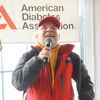I am totally blind and a very brittle type I diabetic. I was recently profiled in the American Diabetes Association's Diabetes Forecast because I've not let my challenges stop me from doing things healthy people haven't done or tried to do. As a motivational speaker, advocate for changes in US health professions training, and graduate of Yale, Princeton and Harvard, I often do "difficult" things. I have even completed a rollerblading marathon. "How has he done all of this?" you may wonder. Well, it takes lots of thought and planning, and literally hundreds of people who have chosen to help me.
For someone who doesn't have significant challenges to manage, it's hard to truly understand the difference between our lives. Here's an example of what I, and many people who are either chronically ill or disabled, need to do to make a comparatively "easy" day trip to the city happen.
Let's say you live near a major city and go in for the day. Take New York City, for example. If you live near NYC, you probably either hop in your car or drive to a local train station and take commuter rail. If you drive, the GPS on your smart phone can guide you to where you need to go if you can't figure it out. If you take the train, you get to Manhattan and then take the subway or a taxi to wherever you're going, possibly with help from an app.
Now, let's talk about how I do this same trip: First, I decide I need to go to NYC. Second, I think about how I'm going to get from my apartment in New Haven to the train station. This probably involves a sighted guide, partly because there's lots of construction here which makes maneuvering sidewalks dangerous for me, even with my years of training on "orientation and mobility". Or I might have to take a taxi or rideshare. Part of the need for a guide is the simple fact that although train stations try to be consistent about where trains come to, this can vary. You would probably race to the track you needed after glancing at the announcement board. I usually need help with this. Some strangers are nice; some won't help someone they don't know. Asking for help therefore has to be planned for at the cost of greater trip time and less personal security. Fortunately, I have lots of willing volunteers and a student assistant (whom I pay for) to help with these things.
Once I'm on the train, I can sit back....until I get to Grand Central. Then, I usually have three options: I can move out with the guide (whose train fare I've paid for), I find someone to help me access public transportation; or, I can meet someone who is expecting me in the city. As an active, accomplished person, I don't usually visit the same places each time and so I can't know the streets and buildings as I would if I was in New Haven.
So, either a guide comes with me or someone meets me in NYC end of the train line. I could hope for someone to help me in New York, but it's possible they could have bad intentions for "an easy mark". There's no way for me to "see" this. If someone's meeting me, I have to hope they aren't stuck in traffic, particularly since not all platforms in Grand Central Terminal have good cell reception which makes tracking each other down much harder.
Assuming we find each other, all's well ...Well, until its time for my meds. Fortunately, most of my friends know how to follow my blood glucose monitoring and insulin dosage measurement protocol. I can't do this on my own. For a blind diabetic, no technology exists to safely and reliably get a small blood drop into a test strip that is about the size of a sunflower seed. The meter can read out the sugar level, but if it doesn't get a good sample the reading is wrong. Similarly, insulin pens pose another problem for blind diabetics. If I accidentally miss count a click of the pen, I will have administered the wrong insulin dosage. Even manufacturers of the insulin pens say they're not safe for a totally blind person to use unless in emergency situations. The pump isn't an option either. If I am meeting people for business I need someone with me, who can do my meds or nearby to meet me when needed. So: a trip I recently took to the city to see a VP at a pharmaceutical company and get some rollerblading video for my website looks like:
Decide to go in at least a week ahead.
Find guide to train in New Haven.
Make sure Jessica, NY area Research Assistant can help with Pharma appointment and do afternoon work.
Jess can do lunch meds.
Confirm Pharma appointment.
Find quiet place to do afternoon work since coffee shops are too loud for us to talk easily.
Compile data with Jess showing most health professions students don't learn how chronically ill and disabled patients function at home and work.
Jess gets me to Sara.
Sara is guide for rollerblading video and does dinner meds.
Guess on "right dose" given unusual food and activity.
Meet Heather, videographer.
Film video of rollerblading in Central Park.
Sara takes me to train in NYC.
Meet Nicole, paid assistant, in New Haven.
Go home to work on my book. It has stories from 125 of the amazing people who supported me in earning three master's degrees and my genetics PhD; helping launch a $150 million research center; traveling around the world; skiing, hiking, and kayaking regularly; and why they got involved. I hope it inspires people to help others as much as these amazing people have inspired and supported me in all that I've done.
